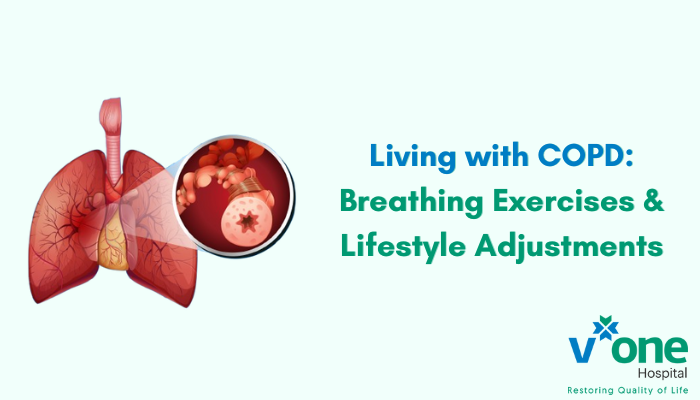Living with COPD: Breathing Exercises and Lifestyle Adjustments
If you’ve been diagnosed with Chronic Obstructive Pulmonary Disease (COPD), you’re probably experiencing a lot of emotions—frustration, worry, or maybe even a sense of loss as you come to terms with changes in your daily life. But here’s the good news: while COPD can be a lifelong condition, there are many ways to manage it effectively. With the right breathing exercises and lifestyle adjustments, you can still live a fulfilling and active life. Let’s explore some practical strategies together!
Understanding COPD and How It Affects You
Before diving into breathing exercises and lifestyle changes, it’s important to understand what COPD is and how it impacts your body.
COPD is an umbrella term for a group of lung conditions that cause breathing difficulties, primarily chronic bronchitis and emphysema. People with COPD often feel short of breath, especially during physical activities. You may find yourself coughing, wheezing, or producing excess mucus. These symptoms can understandably make day-to-day life more challenging, but with some mindful adjustments, you can regain a sense of control over your health.
Why Breathing Exercises Matter
When you have COPD, your lungs don’t work as efficiently as they used to. This makes it harder for oxygen to get in and for carbon dioxide to get out. The goal of breathing exercises is to improve your lung function and help you use the air you breathe more effectively. By practicing these exercises regularly, you can reduce shortness of breath and increase your stamina.
Let’s go over a few of the most helpful breathing exercises for COPD.
1. Pursed-Lip Breathing
This is one of the simplest and most effective exercises for managing shortness of breath. Pursed-lip breathing helps slow your breathing, keeps your airways open longer, and allows for better oxygen exchange.
How to do it:
- Breathe in through your nose for about two seconds.
- Purse your lips (like you’re about to whistle).
- Breathe out slowly and gently through your pursed lips for about four seconds, or as long as is comfortable.
- Repeat this a few times when you’re feeling out of breath or during physical activities.
This exercise is a great go-to when you’re climbing stairs or walking up a hill and suddenly feel winded.
2. Diaphragmatic (Belly) Breathing
The diaphragm is a large muscle located just below your lungs, and it plays a big role in breathing. Diaphragmatic breathing focuses on using this muscle more effectively to get deeper breaths, which is important when living with COPD.
How to do it:
- Sit or lie down in a comfortable position.
- Place one hand on your chest and the other on your belly.
- Breathe in slowly through your nose, letting your belly push your hand out while keeping your chest as still as possible.
- Exhale through pursed lips, letting your belly move inward.
- Practice this for about 5–10 minutes a few times each day.
This exercise helps you focus on taking deeper, more controlled breaths, which can improve your overall lung function.
3. Coordinated Breathing
If you find yourself getting short of breath during activities like walking, exercising, or even just doing household chores, coordinated breathing can help you manage that better.
How to do it:
- Breathe in through your nose before you start an activity.
- Breathe out through pursed lips during the hardest part of the activity. For example, if you’re lifting something, breathe out as you lift.
- Repeat this during any activity that causes shortness of breath.
This technique helps you pace yourself and avoid sudden bouts of breathlessness.
Lifestyle Adjustments for Living Well with COPD
In addition to breathing exercises, making some lifestyle changes can significantly improve your quality of life with COPD. Let’s look at a few practical tips.
1. Stay Active, But Pace Yourself
It might seem counterintuitive, but staying physically active is one of the best things you can do for your lungs. Regular exercise strengthens your respiratory muscles, improves circulation, and boosts overall stamina.
That said, it’s important to listen to your body and not overexert yourself. Walking, light aerobics, or gentle yoga can be great ways to keep moving without straining your lungs. You can gradually increase your activity level as you feel more comfortable.
2. Healthy Eating for Better Breathing
Did you know that what you eat can impact your breathing? Maintaining a healthy weight is crucial when you have COPD. Being overweight can make it harder to breathe, while being underweight can weaken your respiratory muscles.
Aim for a balanced diet with plenty of fruits, vegetables, lean proteins, and whole grains. If you’re unsure about what to eat, a dietitian can help you create a meal plan that supports your respiratory health.
3. Create a Clean and COPD-Friendly Environment
Your home environment plays a huge role in managing COPD symptoms. Here are some simple ways to make your living space more lung-friendly:
Avoid Smoke: If you smoke, quitting is the most important step you can take to improve your lung health. Also, avoid secondhand smoke and environments with air pollution.
Use Air Purifiers: Air purifiers with HEPA filters can help reduce dust, allergens, and other particles that can irritate your lungs.
Minimize Strong Odors: Strong chemical smells, perfumes, and cleaning products can trigger COPD symptoms. Use fragrance-free, non-toxic cleaning products whenever possible.
4. Manage Stress and Anxiety
Living with a chronic condition like COPD can be emotionally challenging, leading to feelings of stress, anxiety, or even depression. These emotions can actually make your symptoms worse, so managing your mental health is just as important as managing your physical health.
Mindfulness, meditation, and deep-breathing exercises can help calm your mind and reduce stress. If you find yourself feeling overwhelmed, consider talking to a therapist or joining a support group where you can share your experiences with others who understand what you’re going through.
5. Regular Checkups and Medications
Lastly, it’s important to keep up with regular doctor visits and take your medications as prescribed. Your healthcare provider can monitor your lung function, adjust your treatment plan if necessary, and help you manage any flare-ups before they become serious.
Final Thoughts
Living with COPD can be challenging, but with the right breathing exercises, lifestyle adjustments, and medical support, you can take control of your condition and live a fulfilling life. Remember, it’s about making small, manageable changes that support your overall well-being. Take it one step at a time, and don’t hesitate to reach out to your healthcare team whenever you need guidance or support.
You’ve got this, and you’re not alone! With these strategies, managing COPD becomes much more achievable, empowering you to breathe easier and enjoy life to the fullest.

